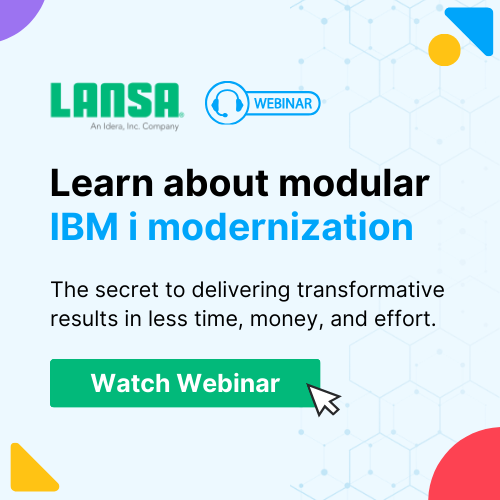You don’t hear about CA 2E (also known as Synon ) technology very often these days. It was once, however, by far the most popular third-party application development solution for IBM i. In fact, the Synon company was a pioneer in rapid application development. Fast forward, and now people only talk about it in terms of application modernization strategies.
Synon/2E, released in 1987, remained one of the most popular solutions used to develop apps for the IBM i platform — originally launched as AS/400 — for years. Many long-time IBM i users tend to think of Synon/2E with great affection. In the early days of IBM i, Synon/2E allowed organizations to rapidly create custom applications and systems that were considered cutting-edge business technology. Synon apps powered some of the most critical business operations. The majority of them have proven extremely effective and reliable over the years. So much so, in fact, that many organizations continue to rely on CA 2E apps to this day.
No matter how functional Synon applications may be, however, you can’t ignore that CA 2E is already 35 years old. The majority of Synon apps were developed decades ago. They can only be described as legacy, They have features that often make them obsolete and problematic in the modern-day business environment. This, of course, is not news for the majority of organizations that are using Synon apps as part of their IT infrastructure today. As a result, many are actively looking for Synon application modernization strategies and the tools to implement them.
What are the key elements of the best Synon application modernization strategies?
There are certain things you should not forget when you discuss the modernization of outdated CA 2E applications. Firstly, most of them provide organizations with great business value. Second, in most cases, they are deeply rooted in the existing internal IT infrastructure. As a result, it is not uncommon for companies to face significant challenges when they develop their Synon application modernization strategies.
LANSA has been providing IBM i support services since 1987. Based on our more than extensive experience with transforming legacy IBM i app solutions, three areas are key to truly effective Synon modernization strategies.
Preserve existing CA 2E and IBM i investments
Modernizing Synon applications and other legacy solutions while preserving your investment in IBM i infrastructure is a very tricky thing to do. The most radical approach is to migrate away from IBM i entirely. With this approach, you find a new platform rather than modernizing your outdated solutions. Organizations that decide to migrate completely off IBM i often end up regretting this decision.
There are multiple reasons why, for the majority of companies, modernizing your IBM i software is a better idea than migrating to another platform. First of all, IBM i remains relevant today. It retains its main strengths — an unmatched level of security, superb performance, and reliability. Migration away from IBM i would not only take these away, it also would nullify the years of investment in your IBM i infrastructure.
In addition to the platform investment, Synon legacy apps themselves have a lot of value to preserve. This includes the wealth of data related to business processes you have accumulated over the years. Also consider the business rules and logic incorporated in these tools, a result of years of deep understanding of operations and the specific needs of your company.
Eliminate issues with legacy CA 2E code and IBM i talent shortage
There is another major cornerstone of success in Synon application modernization strategies. That is focusing on fixing the problems related to reliance on legacy programming languages like CA 2E apps and IBM i.
Original CA 2E apps, created in Synon use a specialized language to define an application’s data model and business rules. It is challenging to modernize this legacy code, replace it with a modern programming language, or even RPG. One of the ways to address this is to use a third-party tool able to convert your CA 2E code. Quite often, however, these solutions end up producing very low-quality code that needs manual modification.
In addition to Synon-specific legacy code issues, there is a more general IBM i skills shortage problem. It’s well-known that the talent pool of IBM i developers is shrinking rapidly as senior RPG programmers retire. At the same time, new coders understandably choose to focus on learning modern programming languages.
Solving both these issues with a smart choice of tools and software development approaches is a part of a successful Synon application modernization strategy.
Enhancing old Synon app design and business logic to make them more agile
To enhance old Synon app design and make systems more agile there is a third key component. This is to enhance and modernize CA 2E apps as opposed to just creating new versions with the business logic. Modernizing Synon apps is not just changing their code. It is also about making sure they have both modern design and modern business logic.
Making the new apps easy to integrate with software tools and solutions that are part of enterprise IT infrastructure is also crucial. That is why your Synon application modernization strategies should focus on making your new apps as agile as possible.
How to comply with all 3 key components of Synon app modernization strategies?
If complying with all three of these requirements seems difficult to achieve, it’s because it is. For many, choosing the right tools isn’t a component of their application modernization strategy. But, in many cases, it is even more important. Simply put, the solutions you choose for your Synon modernization strategy will make or break your modernization initiative.
Visual LANSA
Visual LANSA is a comprehensive low-code rapid application development platform. It allows companies to build enterprise-grade mobile, web, and desktop apps. LANSA has been working with the IBM i platform since its release at the end of the 1980s. Its extensive knowledge of IBM i ecosystems shows in all its products. The Visual LANSA platform provides several exclusive solutions for IBM i developers. These include tools that enable the easy creation of IBM i web apps.
Visual LANSA empowers your current RPG developers. It provides them with a set of tools for creating universal enterprise solutions without learning new programming languages or coding techniques. It also supports the modernization of legacy IBM i apps and migrating them to the cloud.
LANSA uses your existing systems and developer skills, so it doesn’t require costly investments into IT infrastructure updates to transform Synon legacy apps. LANSA also has multiple tools to enable the digital transformation of your IBM i systems at little to no cost. It has been helping enterprise technical teams modernize and expand the functionality of the IBM i since its initial release.
RAMP (Rapid Application Modernization Process)
Rapid Application Modernization Process (RAMP) is an incremental modernization approach that combines the best aspects of refacing existing applications and new development. By consolidating existing functionality with new capabilities inside the RAMP application framework, you get the applications you want without having to throw everything away. RAMP performs modernization in stages. You can introduce new functionality incrementally without a serious impact on your business operations. As a result, your user interface becomes consistent across all of your applications.
Looking for more information on AS400 Application Modernization? Check out our guide.
How Eagle Systems modernized its core Synon 2E-based logistics system with LANSA
Here’s a case study showing how proper Synon application modernization strategies can deliver great business results when combined with the LANSA arsenal of low-code tools and rapid app development solutions.
Eagle Systems, a leader in intermodal transportation with locations throughout the USA and Canada, chose the Visual LANSA Framework to build a dispatch system called eDray. eDray integrates with its core Synon 2E-based logistics system. Eagle Systems uses LANSA Integrator to exchange dispatch information via SMS with drivers and send real-time EDI status updates to customers.
You can download a full version of this case study here.
Bulletproof your Synon application modernization strategies with LANSA and aXes
The LANSA platform combines best practices in modern-day software development and digital transformation. It helps organizations leverage the power of automation and digital transformation technologies. LANSA is the solution for organizations that need to implement IBM i modernization and data integration quickly, reliably, and with limited developer resources.
One LANSA solution created specifically for IBM i users is aXes. aXes is a tailor-made tool that automates the creation of web-enabled IBM i applications. Out-of-the-box, aXes allows organizations to easily transform their existing Synon/2E-based applications into web pages, without changing source code.
aXes includes an API that allows developers to create programs that automatically operate applications written with RPG or COBOL. Applications can also use aXes to simulate the actions of a person entering data on screens in a Synon application. This feature makes it possible to integrate existing Synon apps with .NET, Java, or 5250 applications without changing their source code. aXes caters to a wide range of automation options with versions of the API for .NET for Windows, Java for IBM i and Windows, and RPG for IBM i.
Get first-hand LANSA knowledge on legacy app modernization
Modernization is an overwhelming process that can either make or break a company. That’s why planning and strategizing for IBM i modernization is so important. We combined all the fundamental knowledge about the enterprise application modernization process in a whitepaper titled “Application Modernization For Dummies, LANSA Edition.” You can download it for free on this page.
Ready to begin? Get in touch with us to start using Visual LANSA for your app development and modernization.










